Jiajie Su
Distilling Transitional Pattern to Large Language Models for Multimodal Session-based Recommendation
Apr 13, 2025Abstract:Session-based recommendation (SBR) predicts the next item based on anonymous sessions. Traditional SBR explores user intents based on ID collaborations or auxiliary content. To further alleviate data sparsity and cold-start issues, recent Multimodal SBR (MSBR) methods utilize simplistic pre-trained models for modality learning but have limitations in semantic richness. Considering semantic reasoning abilities of Large Language Models (LLM), we focus on the LLM-enhanced MSBR scenario in this paper, which leverages LLM cognition for comprehensive multimodal representation generation, to enhance downstream MSBR. Tackling this problem faces two challenges: i) how to obtain LLM cognition on both transitional patterns and inherent multimodal knowledge, ii) how to align both features into one unified LLM, minimize discrepancy while maximizing representation utility. To this end, we propose a multimodal LLM-enhanced framework TPAD, which extends a distillation paradigm to decouple and align transitional patterns for promoting MSBR. TPAD establishes parallel Knowledge-MLLM and Transfer-MLLM, where the former interprets item knowledge-reflected features and the latter extracts transition-aware features underneath sessions. A transitional pattern alignment module harnessing mutual information estimation theory unites two MLLMs, alleviating distribution discrepancy and distilling transitional patterns into modal representations. Extensive experiments on real-world datasets demonstrate the effectiveness of our framework.
Enhancing Attributed Graph Networks with Alignment and Uniformity Constraints for Session-based Recommendation
Oct 14, 2024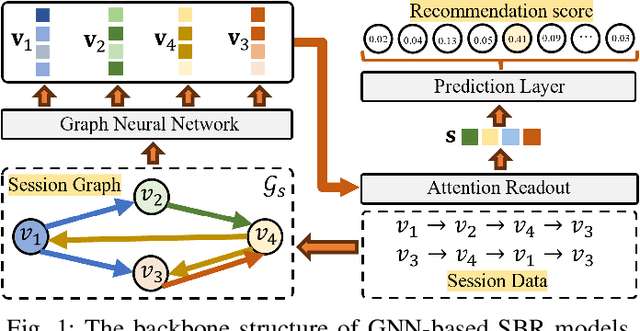
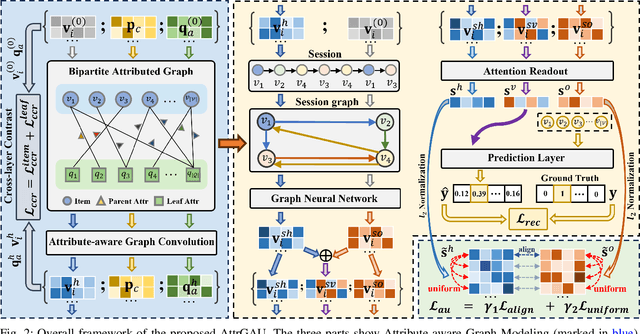
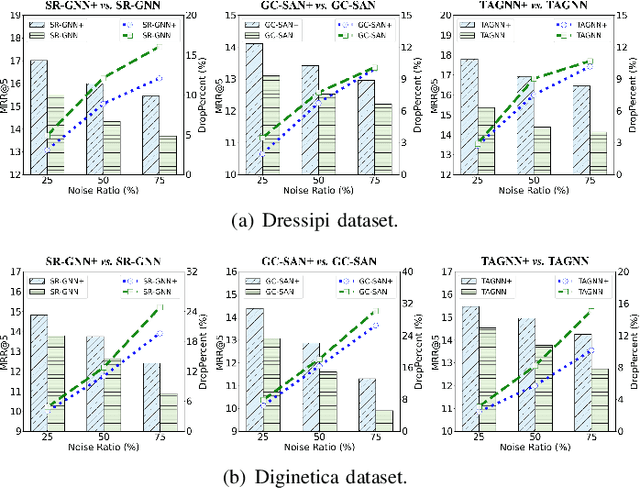

Abstract:Session-based Recommendation (SBR), seeking to predict a user's next action based on an anonymous session, has drawn increasing attention for its practicability. Most SBR models only rely on the contextual transitions within a short session to learn item representations while neglecting additional valuable knowledge. As such, their model capacity is largely limited by the data sparsity issue caused by short sessions. A few studies have exploited the Modeling of Item Attributes (MIA) to enrich item representations. However, they usually involve specific model designs that can hardly transfer to existing attribute-agnostic SBR models and thus lack universality. In this paper, we propose a model-agnostic framework, named AttrGAU (Attributed Graph Networks with Alignment and Uniformity Constraints), to bring the MIA's superiority into existing attribute-agnostic models, to improve their accuracy and robustness for recommendation. Specifically, we first build a bipartite attributed graph and design an attribute-aware graph convolution to exploit the rich attribute semantics hidden in the heterogeneous item-attribute relationship. We then decouple existing attribute-agnostic SBR models into the graph neural network and attention readout sub-modules to satisfy the non-intrusive requirement. Lastly, we design two representation constraints, i.e., alignment and uniformity, to optimize distribution discrepancy in representation between the attribute semantics and collaborative semantics. Extensive experiments on three public benchmark datasets demonstrate that the proposed AttrGAU framework can significantly enhance backbone models' recommendation performance and robustness against data sparsity and data noise issues. Our implementation codes will be available at https://github.com/ItsukiFujii/AttrGAU.
Personalized Behavior-Aware Transformer for Multi-Behavior Sequential Recommendation
Feb 22, 2024



Abstract:Sequential Recommendation (SR) captures users' dynamic preferences by modeling how users transit among items. However, SR models that utilize only single type of behavior interaction data encounter performance degradation when the sequences are short. To tackle this problem, we focus on Multi-Behavior Sequential Recommendation (MBSR) in this paper, which aims to leverage time-evolving heterogeneous behavioral dependencies for better exploring users' potential intents on the target behavior. Solving MBSR is challenging. On the one hand, users exhibit diverse multi-behavior patterns due to personal characteristics. On the other hand, there exists comprehensive co-influence between behavior correlations and item collaborations, the intensity of which is deeply affected by temporal factors. To tackle these challenges, we propose a Personalized Behavior-Aware Transformer framework (PBAT) for MBSR problem, which models personalized patterns and multifaceted sequential collaborations in a novel way to boost recommendation performance. First, PBAT develops a personalized behavior pattern generator in the representation layer, which extracts dynamic and discriminative behavior patterns for sequential learning. Second, PBAT reforms the self-attention layer with a behavior-aware collaboration extractor, which introduces a fused behavior-aware attention mechanism for incorporating both behavioral and temporal impacts into collaborative transitions. We conduct experiments on three benchmark datasets and the results demonstrate the effectiveness and interpretability of our framework. Our implementation code is released at https://github.com/TiliaceaeSU/PBAT.
DDGHM: Dual Dynamic Graph with Hybrid Metric Training for Cross-Domain Sequential Recommendation
Sep 21, 2022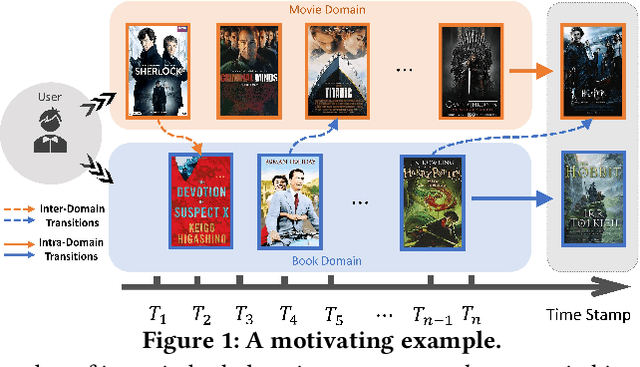
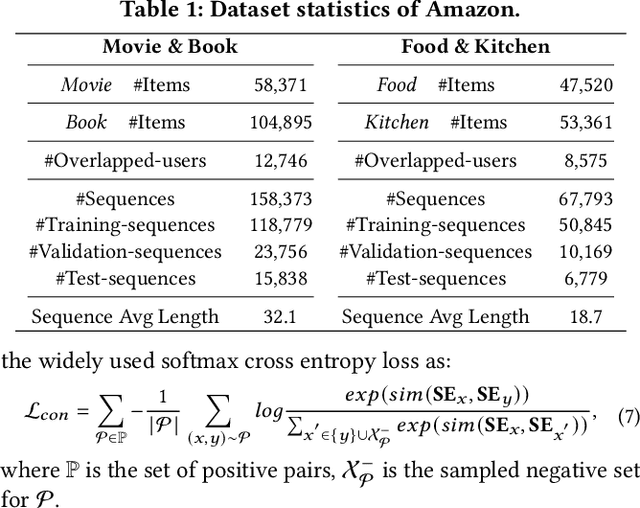
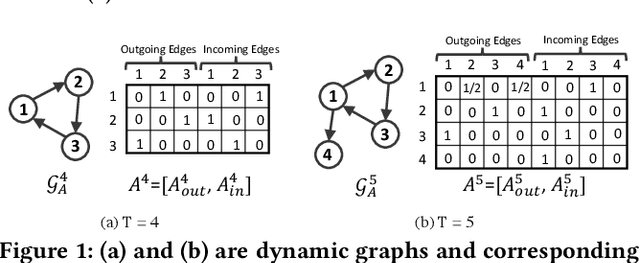
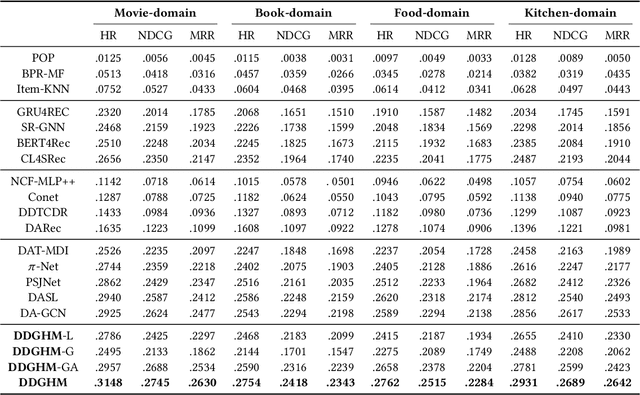
Abstract:Sequential Recommendation (SR) characterizes evolving patterns of user behaviors by modeling how users transit among items. However, the short interaction sequences limit the performance of existing SR. To solve this problem, we focus on Cross-Domain Sequential Recommendation (CDSR) in this paper, which aims to leverage information from other domains to improve the sequential recommendation performance of a single domain. Solving CDSR is challenging. On the one hand, how to retain single domain preferences as well as integrate cross-domain influence remains an essential problem. On the other hand, the data sparsity problem cannot be totally solved by simply utilizing knowledge from other domains, due to the limited length of the merged sequences. To address the challenges, we propose DDGHM, a novel framework for the CDSR problem, which includes two main modules, i.e., dual dynamic graph modeling and hybrid metric training. The former captures intra-domain and inter-domain sequential transitions through dynamically constructing two-level graphs, i.e., the local graphs and the global graph, and incorporating them with a fuse attentive gating mechanism. The latter enhances user and item representations by employing hybrid metric learning, including collaborative metric for achieving alignment and contrastive metric for preserving uniformity, to further alleviate data sparsity issue and improve prediction accuracy. We conduct experiments on two benchmark datasets and the results demonstrate the effectiveness of DDHMG.
Differential Private Knowledge Transfer for Privacy-Preserving Cross-Domain Recommendation
Feb 10, 2022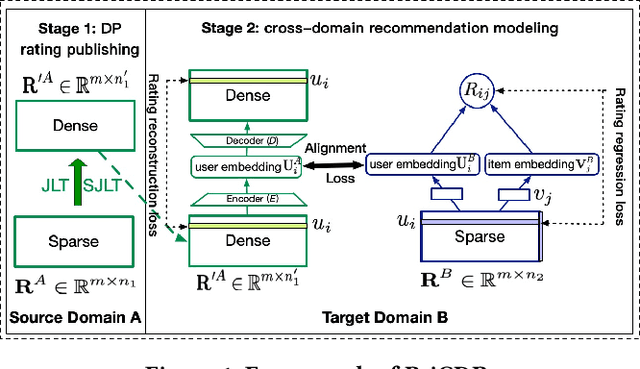
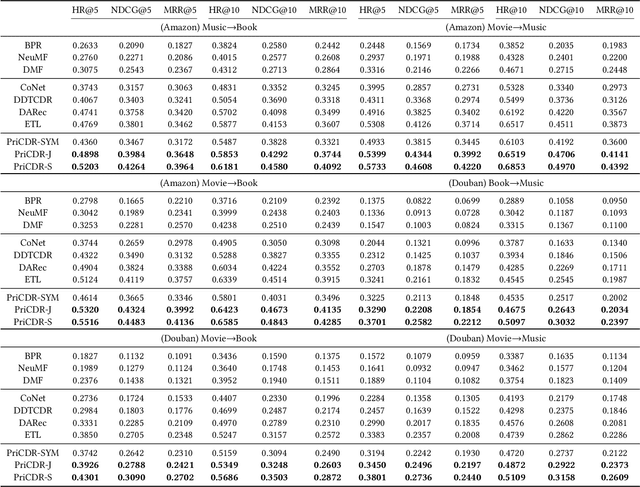
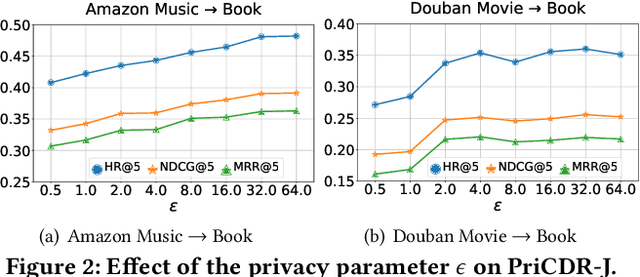
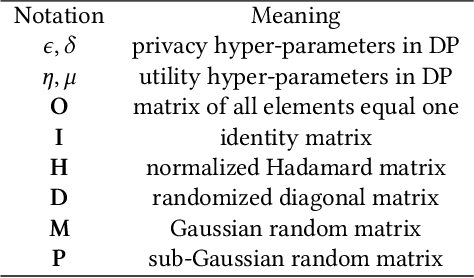
Abstract:Cross Domain Recommendation (CDR) has been popularly studied to alleviate the cold-start and data sparsity problem commonly existed in recommender systems. CDR models can improve the recommendation performance of a target domain by leveraging the data of other source domains. However, most existing CDR models assume information can directly 'transfer across the bridge', ignoring the privacy issues. To solve the privacy concern in CDR, in this paper, we propose a novel two stage based privacy-preserving CDR framework (PriCDR). In the first stage, we propose two methods, i.e., Johnson-Lindenstrauss Transform (JLT) based and Sparse-awareJLT (SJLT) based, to publish the rating matrix of the source domain using differential privacy. We theoretically analyze the privacy and utility of our proposed differential privacy based rating publishing methods. In the second stage, we propose a novel heterogeneous CDR model (HeteroCDR), which uses deep auto-encoder and deep neural network to model the published source rating matrix and target rating matrix respectively. To this end, PriCDR can not only protect the data privacy of the source domain, but also alleviate the data sparsity of the source domain. We conduct experiments on two benchmark datasets and the results demonstrate the effectiveness of our proposed PriCDR and HeteroCDR.
 Add to Chrome
Add to Chrome Add to Firefox
Add to Firefox Add to Edge
Add to Edge